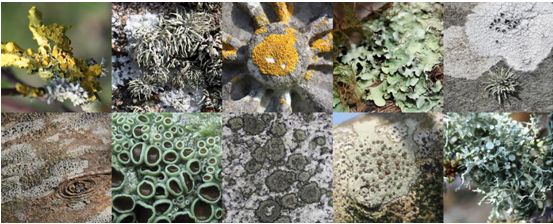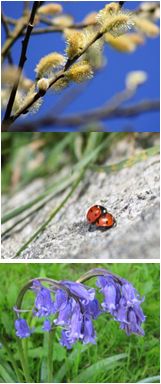March has hailed the true start of spring, with mixed, sometimes turbulent weather and fluctuating temperatures, while the end of the month has been almost balmy. There is new colour and form everywhere, as members of the plant and animal kingdoms prepare for the serious business of reproduction, induced by lengthening daylight and increasing average temperature.
Amidst all the busy activity there are also other, much subtler organisms, neither of the plant nor animal classification, that contribute equally richly to the unique beauty of the Roseland landscape. These organisms are all around us, and though they may not be immediately obvious, one will not have to look too long or too far to find them. They are the lichens.
Lichens are not single life forms, rather, they are an intriguing and interdependent partnership of two (and rarely, three) organisms. One partner is a fungus (called the mycobiont); the other (called the photobiont) is most commonly a bacterium (occasionally an alga, which is a plant organism). Fungi and bacteria (and also the viruses) are now classified in their own life kingdoms, entirely separate from plants and animals and from each other. Recent genetic science has, moreover, shown us that the fungi are more closely connected to animal rather than plant life forms, because of their chemical structure.
 The photobiont partner in a lichen structure is so called because, like plants, it generates nutritive energy from sunlight, rather as plants do using photosynthesis. This energy is shared with the mycobiont, whose job is to provide the structural form in which both organisms can live as one: a symbiotic relationship.
The photobiont partner in a lichen structure is so called because, like plants, it generates nutritive energy from sunlight, rather as plants do using photosynthesis. This energy is shared with the mycobiont, whose job is to provide the structural form in which both organisms can live as one: a symbiotic relationship.
In this way lichens can thrive in the toughest places, often where competition with other organisms for direct sunlight is minimal. Thus you will find them on bare rock, exposed tree trunks, stone walls, brick, concrete and other composite, often man-made materials. Lichens do not need soil, since they would derive no nutritional benefit from it. They need moisture and yet they can survive periods of severe desiccation by going dormant until conditions become more favourable for growth and development. Their growth is characterized, not only by their symbiosis but also to some extent by the constraints of the surface upon which they accidentally find themselves. Their proliferation is haphazard, dependent upon environmental constraints beyond their control.
Lichen morphology is classed into four main groups, further divided into sub-categories. Those in the crustose group grow as the name suggests, as a crusty layer, attached entirely to the substrate surface. The group known as the squamulose lichens form series of flattened, scaley growths. Next are the foliose lichens, which form layered structures attached to the substrate by one or more umbliical or root-like stems or threads. Finally, there are the fruticose lichens, those that grow into bushy or many-branching forms looking like strange, miniature bushes or shrubs.
A lichen takes its species name from the fungal partner’s species definition, since it is the fungus that gives the lichen its principal morphological characteristics. There are thought to be around 1800 species of lichens in the UK as a whole but the list is still increasing. Just how many of these 1800 are represented here in the Roseland is unknown. Lichens growing thickly on the branches of trees and small shrubs are to be found all over the Roseland. Lichen development can often be adversely affected by airborne pollution, The anecdotal evidence around us suggests that the Roseland air is particularly clean and well-balanced.
 Here are a few more interesting facts about lichens:
Here are a few more interesting facts about lichens:
v While some lichens are ubiquitous, some are so rare that they must be protected by national and international law, to curb environmental damage or disturbance to their habitat
v Some lichens grow less than 1mm per year, so their size can indicate not only their age but that of the substrate upon which they grow
v Some bird species use pieces of lichen to disguise their nests, protecting them from predators
v Lichens do not have great nutritional value but nonetheless are consumed by a variety of species, including humans
v Lichens have been and are still used traditionally to make dyes and other chemical compounds useful to humans
Lichens are particularly good to see and photograph at times of the year when the weather favours them – generally spring and autumn. For further facts and information about lichens, see the references below.
Some things to look out for in April…
The warm finish to March has already enticed the early emergence of somenoteworthy insect species. Bumblebees (Bombus spp) and hover flies are finding nectar among wild plants and shrubby trees such as the goat willows (Salix caprea) (depicted right). You may also have noticed the already apparent abundance of ladybirds (Coccinellidae spp) in gardens, hedgerows and fields. The UK Ladybird Survey would like you to tell them about all the different kinds of ladybird you see. If you have children, sending in your ladybird sightings would be a great way to introduce them to wildlife watching and recording.
Look out too for the butterflies appearing. I saw my first small tortoiseshell (Aglais urticae) on March 28th. Peacocks (Inachis io) and the beautiful yellow Brimstone (Gonepterix rhamni) also like the warm, bright days and will be emerging soon to greet the spring.
In the woodlands the sweetly scented bluebells (Hyacinthoides non-scripta) are emerging to join the throng of primroses, violets and lesser celandines already competing for space and creating joyful carpets of colour along our Cornish hedges. See if you can spot the difference between true, native wild bluebells and the horticulturally introduced Spanish species (Hyacinthoides hispanica) and their resultant hybrids with English bluebells. The Natural History Museum have published an online guide here to help you. They are also asking for help with a new survey, looking at the differences between the flowering times of English and Spanish Bluebells, which may help them learn more about the effects of climate change.
References
Bungartz, F. (2012) An overview on the biology of lichens. Internet. Available from: http://nhc.asu.edu/lherbarium/lichen_info/index.php
PURVIS, O. W. (2000): Lichens. Smithsonian Institution Press, Washington, 112 pp.
Sarah Vandome
